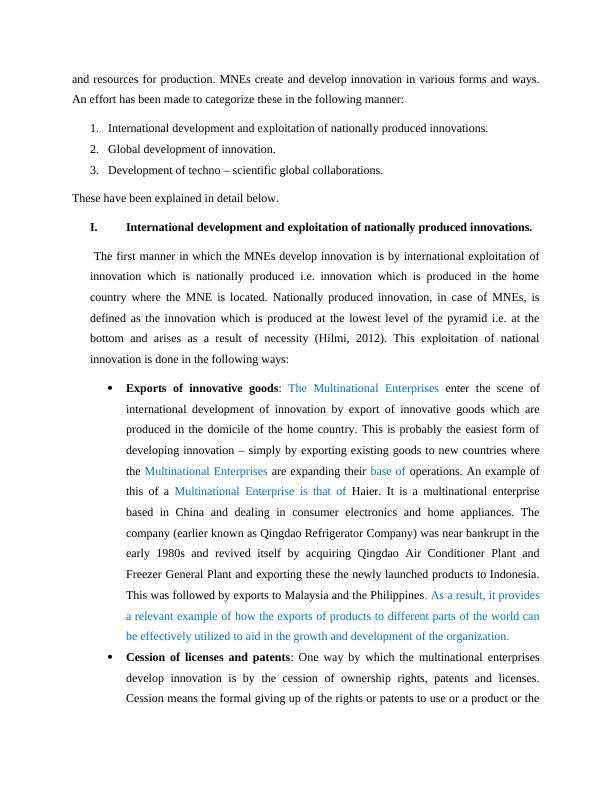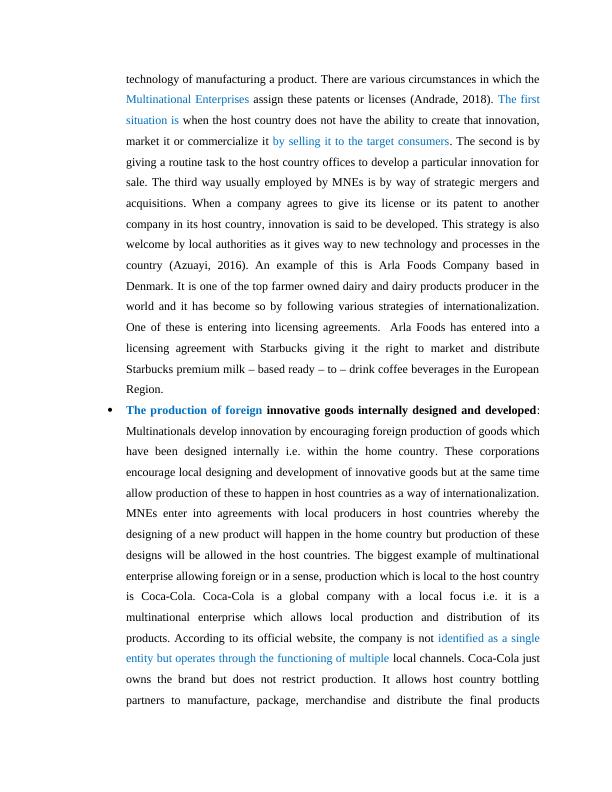How Multinational Enterprises Develop Innovation
Added on 2023-04-07
12 Pages3045 Words84 Views
TITLE PAGE

A multinational enterprise (MNE) is defined to be a company or a corporation that is registered
and/or functions in more than one country apart from the original home country. It is an
enterprise that manages products and delivers services in a number of countries across the world.
It is also referred to as an international corporation or a multinational corporation (MNC). A
multinational enterprise has been defined by the International Labor Organization as a
corporation which has its headquarters in one country which is known as the home country or the
native country of origin of the organization and other offices or branches in some other countries
apart from the original country known as the host country. While having being located in
different countries is one of the prime criterion for defining multinational enterprises, not all
theorists agree with it. There are many criteria which needs to be full filled before an
organization can be termed as a Multinational Enterprise .Many have argued that an enterprise is
identified as a multinational organization only when the parent company is controlled and owned
by the native citizens of at least two countries and more (Weedmark, n.d.). Apart from
ownership, a business organization that has production units or sectors in several nation states of
the world, has direct control and dominance over all its international functioning units and
operations and has varied investment in foreign production, is known as a multinational
enterprise. The Multinational Enterprises usually enjoy immense benefits that the other business
organizations and normal corporations do not. For example, increased market penetration, huge
assets, increased turnover, reduction in shipping and freight costs and benefits of taxation. The
purpose of this essay is to give a detailed explanation of how Multinational Enterprises work
with reference to the given question.
Where and how is innovation developed by MNEs?
Innovation is the action or process of innovating – of creating something new with the help of
new ideas, new thoughts and new actions or methods. In this process of creating something new,
multinational enterprises play a key role. MNEs have an advantage over other corporations due
to their size and by virtue of serving more than one markets. These companies take a front seat
when it comes to developing innovation - they benefit from the economies of scale of production
and the ability to invest in high risk projects. MNEs have also, in search of developing and
processing innovation, have modified their strategies so as to aim at increasing efficiency,
reducing costs, increasing sales in foreign markets and tapping into previously unexplored areas
and/or functions in more than one country apart from the original home country. It is an
enterprise that manages products and delivers services in a number of countries across the world.
It is also referred to as an international corporation or a multinational corporation (MNC). A
multinational enterprise has been defined by the International Labor Organization as a
corporation which has its headquarters in one country which is known as the home country or the
native country of origin of the organization and other offices or branches in some other countries
apart from the original country known as the host country. While having being located in
different countries is one of the prime criterion for defining multinational enterprises, not all
theorists agree with it. There are many criteria which needs to be full filled before an
organization can be termed as a Multinational Enterprise .Many have argued that an enterprise is
identified as a multinational organization only when the parent company is controlled and owned
by the native citizens of at least two countries and more (Weedmark, n.d.). Apart from
ownership, a business organization that has production units or sectors in several nation states of
the world, has direct control and dominance over all its international functioning units and
operations and has varied investment in foreign production, is known as a multinational
enterprise. The Multinational Enterprises usually enjoy immense benefits that the other business
organizations and normal corporations do not. For example, increased market penetration, huge
assets, increased turnover, reduction in shipping and freight costs and benefits of taxation. The
purpose of this essay is to give a detailed explanation of how Multinational Enterprises work
with reference to the given question.
Where and how is innovation developed by MNEs?
Innovation is the action or process of innovating – of creating something new with the help of
new ideas, new thoughts and new actions or methods. In this process of creating something new,
multinational enterprises play a key role. MNEs have an advantage over other corporations due
to their size and by virtue of serving more than one markets. These companies take a front seat
when it comes to developing innovation - they benefit from the economies of scale of production
and the ability to invest in high risk projects. MNEs have also, in search of developing and
processing innovation, have modified their strategies so as to aim at increasing efficiency,
reducing costs, increasing sales in foreign markets and tapping into previously unexplored areas

and resources for production. MNEs create and develop innovation in various forms and ways.
An effort has been made to categorize these in the following manner:
1. International development and exploitation of nationally produced innovations.
2. Global development of innovation.
3. Development of techno – scientific global collaborations.
These have been explained in detail below.
I. International development and exploitation of nationally produced innovations.
The first manner in which the MNEs develop innovation is by international exploitation of
innovation which is nationally produced i.e. innovation which is produced in the home
country where the MNE is located. Nationally produced innovation, in case of MNEs, is
defined as the innovation which is produced at the lowest level of the pyramid i.e. at the
bottom and arises as a result of necessity (Hilmi, 2012). This exploitation of national
innovation is done in the following ways:
Exports of innovative goods: The Multinational Enterprises enter the scene of
international development of innovation by export of innovative goods which are
produced in the domicile of the home country. This is probably the easiest form of
developing innovation – simply by exporting existing goods to new countries where
the Multinational Enterprises are expanding their base of operations. An example of
this of a Multinational Enterprise is that of Haier. It is a multinational enterprise
based in China and dealing in consumer electronics and home appliances. The
company (earlier known as Qingdao Refrigerator Company) was near bankrupt in the
early 1980s and revived itself by acquiring Qingdao Air Conditioner Plant and
Freezer General Plant and exporting these the newly launched products to Indonesia.
This was followed by exports to Malaysia and the Philippines. As a result, it provides
a relevant example of how the exports of products to different parts of the world can
be effectively utilized to aid in the growth and development of the organization.
Cession of licenses and patents: One way by which the multinational enterprises
develop innovation is by the cession of ownership rights, patents and licenses.
Cession means the formal giving up of the rights or patents to use or a product or the
An effort has been made to categorize these in the following manner:
1. International development and exploitation of nationally produced innovations.
2. Global development of innovation.
3. Development of techno – scientific global collaborations.
These have been explained in detail below.
I. International development and exploitation of nationally produced innovations.
The first manner in which the MNEs develop innovation is by international exploitation of
innovation which is nationally produced i.e. innovation which is produced in the home
country where the MNE is located. Nationally produced innovation, in case of MNEs, is
defined as the innovation which is produced at the lowest level of the pyramid i.e. at the
bottom and arises as a result of necessity (Hilmi, 2012). This exploitation of national
innovation is done in the following ways:
Exports of innovative goods: The Multinational Enterprises enter the scene of
international development of innovation by export of innovative goods which are
produced in the domicile of the home country. This is probably the easiest form of
developing innovation – simply by exporting existing goods to new countries where
the Multinational Enterprises are expanding their base of operations. An example of
this of a Multinational Enterprise is that of Haier. It is a multinational enterprise
based in China and dealing in consumer electronics and home appliances. The
company (earlier known as Qingdao Refrigerator Company) was near bankrupt in the
early 1980s and revived itself by acquiring Qingdao Air Conditioner Plant and
Freezer General Plant and exporting these the newly launched products to Indonesia.
This was followed by exports to Malaysia and the Philippines. As a result, it provides
a relevant example of how the exports of products to different parts of the world can
be effectively utilized to aid in the growth and development of the organization.
Cession of licenses and patents: One way by which the multinational enterprises
develop innovation is by the cession of ownership rights, patents and licenses.
Cession means the formal giving up of the rights or patents to use or a product or the

technology of manufacturing a product. There are various circumstances in which the
Multinational Enterprises assign these patents or licenses (Andrade, 2018). The first
situation is when the host country does not have the ability to create that innovation,
market it or commercialize it by selling it to the target consumers. The second is by
giving a routine task to the host country offices to develop a particular innovation for
sale. The third way usually employed by MNEs is by way of strategic mergers and
acquisitions. When a company agrees to give its license or its patent to another
company in its host country, innovation is said to be developed. This strategy is also
welcome by local authorities as it gives way to new technology and processes in the
country (Azuayi, 2016). An example of this is Arla Foods Company based in
Denmark. It is one of the top farmer owned dairy and dairy products producer in the
world and it has become so by following various strategies of internationalization.
One of these is entering into licensing agreements. Arla Foods has entered into a
licensing agreement with Starbucks giving it the right to market and distribute
Starbucks premium milk – based ready – to – drink coffee beverages in the European
Region.
The production of foreign innovative goods internally designed and developed:
Multinationals develop innovation by encouraging foreign production of goods which
have been designed internally i.e. within the home country. These corporations
encourage local designing and development of innovative goods but at the same time
allow production of these to happen in host countries as a way of internationalization.
MNEs enter into agreements with local producers in host countries whereby the
designing of a new product will happen in the home country but production of these
designs will be allowed in the host countries. The biggest example of multinational
enterprise allowing foreign or in a sense, production which is local to the host country
is Coca-Cola. Coca-Cola is a global company with a local focus i.e. it is a
multinational enterprise which allows local production and distribution of its
products. According to its official website, the company is not identified as a single
entity but operates through the functioning of multiple local channels. Coca-Cola just
owns the brand but does not restrict production. It allows host country bottling
partners to manufacture, package, merchandise and distribute the final products
Multinational Enterprises assign these patents or licenses (Andrade, 2018). The first
situation is when the host country does not have the ability to create that innovation,
market it or commercialize it by selling it to the target consumers. The second is by
giving a routine task to the host country offices to develop a particular innovation for
sale. The third way usually employed by MNEs is by way of strategic mergers and
acquisitions. When a company agrees to give its license or its patent to another
company in its host country, innovation is said to be developed. This strategy is also
welcome by local authorities as it gives way to new technology and processes in the
country (Azuayi, 2016). An example of this is Arla Foods Company based in
Denmark. It is one of the top farmer owned dairy and dairy products producer in the
world and it has become so by following various strategies of internationalization.
One of these is entering into licensing agreements. Arla Foods has entered into a
licensing agreement with Starbucks giving it the right to market and distribute
Starbucks premium milk – based ready – to – drink coffee beverages in the European
Region.
The production of foreign innovative goods internally designed and developed:
Multinationals develop innovation by encouraging foreign production of goods which
have been designed internally i.e. within the home country. These corporations
encourage local designing and development of innovative goods but at the same time
allow production of these to happen in host countries as a way of internationalization.
MNEs enter into agreements with local producers in host countries whereby the
designing of a new product will happen in the home country but production of these
designs will be allowed in the host countries. The biggest example of multinational
enterprise allowing foreign or in a sense, production which is local to the host country
is Coca-Cola. Coca-Cola is a global company with a local focus i.e. it is a
multinational enterprise which allows local production and distribution of its
products. According to its official website, the company is not identified as a single
entity but operates through the functioning of multiple local channels. Coca-Cola just
owns the brand but does not restrict production. It allows host country bottling
partners to manufacture, package, merchandise and distribute the final products

End of preview
Want to access all the pages? Upload your documents or become a member.
Related Documents
International Business Analysis of eBay | Deskliblg...
|17
|4331
|405
Assignment on International Business - Multi-national Enterpriseslg...
|9
|2086
|16
Challenges Faced by IHR Managers in International Business Operationslg...
|9
|2206
|358
Effect of FDI on Economic Development and Foreign Tradelg...
|9
|2479
|24
Global Business in the Asian Centurylg...
|4
|707
|85
International Business and Multinational Enterpriselg...
|9
|3939
|311
